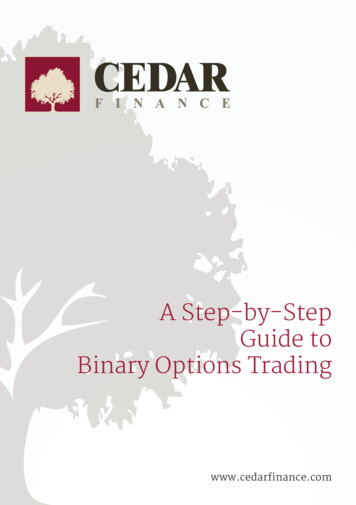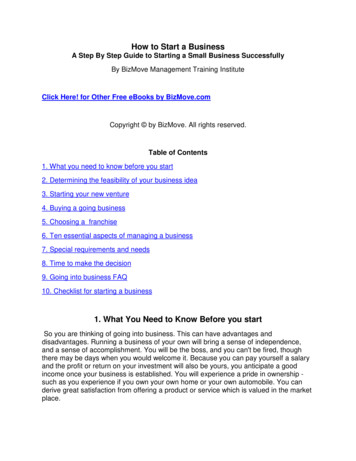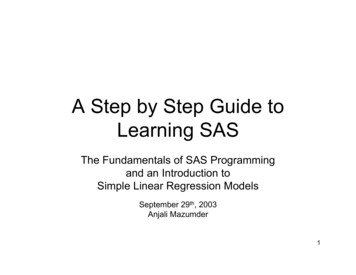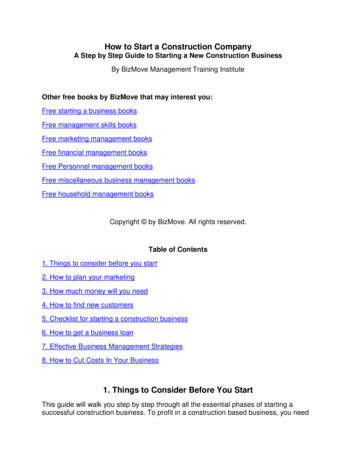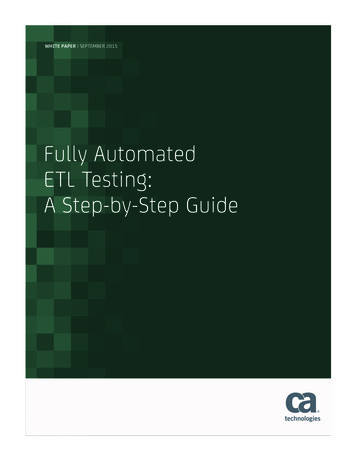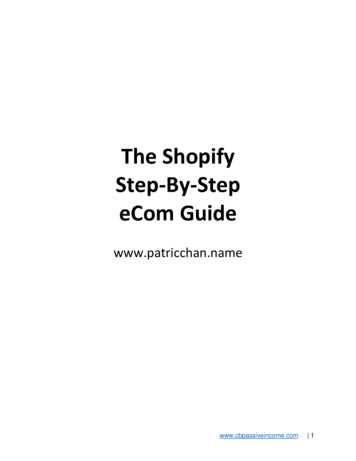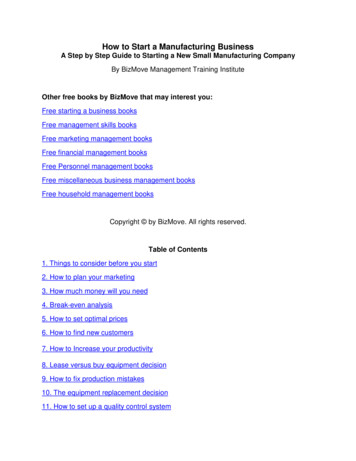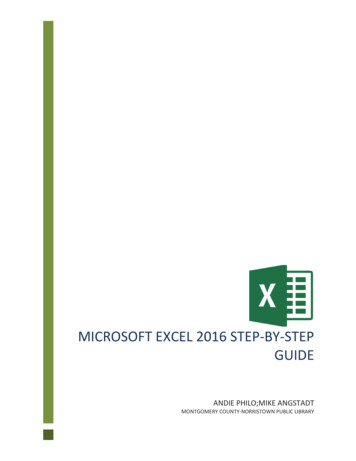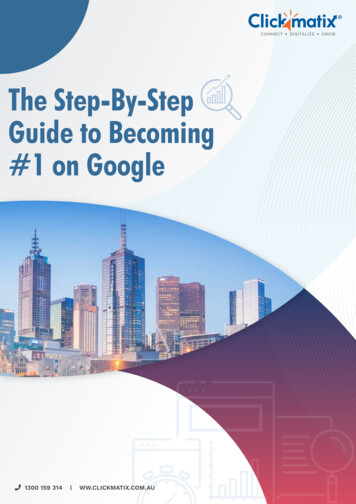
Transcription
CONNECTThe Step-By-StepGuide to Becoming#1 on GoogleDIGITALIZEGROW
TABLE OF CONTENT1.SEO and its impact on businesses3.Do a Keyword Research3.Strong competitors research4.Optimize Your Webpage Content5.Improve Website’s User Experience6.Understanding Google’s Ranking Algorithm7.On-page SEO - Optimise Your Site8.Create an Effective Link-Building Strategy9.Content Marketing10.Boost Your Organic CTR11.Updating the Old Blog Posts12.Check Search Console13.Reduce Your Website’s Bounce Rate14.Use Relevant Internal Linking15.Conversion Rate Optimisation16.Improve Your Local Visibility17.Social ShareCONNECTDIGITALIZEGROW
INTRODUCTIONSearch Engine Optimization or SEO, as everyone calls it, is the most important form of marketing when it comes to online businesses. It helps to gain an organic audience with the help of abasic process of keyword and competition research, on-page and off-page optimization, as wellas an analysis of the results.CONNECTDIGITALIZEGROW
1SEO AND ITS IMPACT ON BUSINESSESSEO is one of the most updated forms of marketing, with Google providing an update annually tokeep up with the trends. Even though digital marketing can provide you with different methods topay and attract an audience, organic growth is what truly gets the numbers rolling and SEO helpsyou achieve exactly that. While it’s easy to theorise, some facts on SEO’s impact are: Google receives over 75,000 searches per second as per Internet Live Stats. 67% of all clicks go to the first five organic results. Advanced Web Ranking discovered theseresults If done right, SEO is capable of receiving a 14.6% conversion rate.Marketers see SEO as becoming more effective, with 82% reporting that effectiveness is onthe rise and 42% of this group stating it is increasing significantly. (Source: MarketDive )Over 90% of pages get no organic results from searches in Google. With so much competitionin the market, and numerous companies spending thousands on SEO-based employment,there are many that don’t receive even a single organic click on Google’s search engine.(Source: Ahrefs Study)CONNECTDIGITALIZEGROW
2SEO AND ITS IMPACT ON BUSINESSES Above everything, content is the most important for an SEO-friendly website. (Via: Databox)With such a broad market in mind, it is important to remember that there is a high rise in the useof mobiles, therefore mobile-based optimization is a must if you do opt for SEO-based marketing.CONNECTDIGITALIZEGROW
3DO A KEYWORD RESEARCHThe first step to achieve a successful SEO is to do a Keyword Research. Keyword research is theprocess of discussing the keywords that will bring the largest amount of quality traffic to yourwebsite. The emphasis lies on it being of ‘quality,’ as it’s not important to just bring an audience;what’s important is to bring the specific audience you need. The process of keyword research isdivided into 4 main points:Define your target audienceKeywords are extremely important, but knowing your audience is even more so. If you simply targeteveryone with your content, you’ll end up reaching no one. SemRush and KeywordTool.io are idealto be able to identify your audience and narrow down some keywords. Google Analytics is also anexcellent tool for audience analysis.CONNECTDIGITALIZEGROW
4DO A KEYWORD RESEARCHAnalyse the keywords you’re targetingKeyword analysis is the starting point of search marketing campaigns. An important part of bothSEO and PPC, is that they help to understand what the queries of the visitors of the website areand, based on that, they help in the customisation of the content to increase traffic and conversionrates. Distributing the budget to only successful keywords helps to optimize spending, so that youcan prioritise your time on areas that actually need your attention and on finding new markets.Google AdWords and WordStream help in keyword analysis. Wordstream’s AdWords PerformanceGrader is free and helps you evaluate long-tail keyword optimization as well as your quality score.Check the search volume and competitionSearch volume data allows you to process the most profitable keywords by letting you know howmany people out there are actually looking for what you are trying to provide. Searchvolume.ioallows you to estimate keyword search traffic for free. When it comes to competitors, you need toknow the rank you hold in relation to every other platform that is providing anything and everythingthat you are. It involves the research of links, keywords, content, and everything about your SEOcompetitors to give you a scope to build on your success. While websites like SpyFu and QuickSprout will help you in analysis, there are also several templates available online to go through thedetails of your ideal ambush.Geo-targeted keywordsLocation-specific landing pages, using keywords that are oriented to the location in which yourbusiness is located, are definitions of Geo-targeted keywords. For example, if your business offers‘chocolate cupcakes,’ it is less likely to show up than it would in a targeted search of ‘chocolatecupcakes in Sydney.’ Google even offers a local pack for SEO optimization, which allows you to fallunder the ‘near me’ option of searches in your city. This can help increase your geo-targeting by73%. You can go as far as to use a Top-Level Domain (recommended for businesses outside theU.S.A.).CONNECTDIGITALIZEGROW
5STRONG COMPETITORS RESEARCHCompetition is always considered to be a healthy part of the industry. It prevents over-confidence,encourages the implementation new creative outlooks, and forces you to find ways to be better atwhat you do every day. Competition instantly complies with customer satisfaction, leaving you tobe at a constant judgement of the market1. Identify your top competitorsBefore getting into the details of everything you can do to overcome the competitors that stand inyour way, it’s important to know who you’re up against in the first place. The ones that are at thetop of the market aren’t necessarily the ones you’re up against in the SEO field. While some showup in your search engine solely on the basis of their brand image, the rest are the competitorsyou’re looking for. Luckily, you can easily know your competitors by writing your top keywords intoGoogle and jotting down the domains of the results.2. Analyse competitor contentPost-identification, you need to work to get key-metrics of every site. This will allow you to have athorough and precise look at the competitor’s assets. The main parts of this procedure are: domainauthority, link sources or any other referring domains, and new domains that are referring back to iton a monthly basis. Link building gives you a scope to increase the number and quality of inboundlinks to your website. Video lengths, word count, the depth of detail they’re willing to cover; all ofthese fall under the type of content they’re trying to create.3. Analyse their SEO structureNow that you have the basics conquered, you can concentrate on the main part: their SEO structure. While your main analysis will be through the overview of metadata and headline strategies,several key metrics can also help. The average monthly visits, page views, bounce rates, time spenton website, traffic divisions based on countries, sources, and demographics are all tiny details thatwill give you an analysis of the impact their SEO structure is creating, and you can further breakthat down with SimilarWeb and Follow.net.CONNECTDIGITALIZEGROW
6STRONG COMPETITORS RESEARCH4. Review competitor back profileThe final, but most important step within a strong competitor research is finding out the source ofyour rivals’ backlinks and using that information to build up on your own profile. Backlinks arecapable of creating a huge impact on a website’s prominence and are key to getting discovered.Backlink checkers like Ahrefs and SEOReviewTools can help you understand how to spot patternsand work towards linking opportunities yourself.CONNECTDIGITALIZEGROW
7OPTIMIZE YOUR WEBPAGE CONTENTContent optimization is the process of making your website more inviting, useful and actionable tothe audience you’re aiming to attract. As important as content truly is, it’s necessary to rememberto function in a way that makes content good from an SEO perspective as well.There are different ways of attracting traffic to your webpage. You can take the pathway oflink-building by making way to a higher domain authority, or be more technical and work with morepages. However, the most recent progressive method is to re-optimise your top content. This canhelp in improving your linkability and search visibility by targeting a safer audience, the audienceyou already have.Technical SEO - More pages More keywords - More trafficLink-building - Higher Domain Authority More trafficRe-optimise top content - Improve Linkability& Search visibility - More trafficWhile working on SEO webpage optimisation, you need to keep the following things in mind: Do not use SEO as a promotional tool, remember to provide the user with what they areactually looking for. If you are able to understand the content your audience wants, feature an enticingcall-to-action that helps them browse similar data with the help of internal links, which canhelp increase your dwell time.CONNECTDIGITALIZEGROW
8OPTIMIZE YOUR WEBPAGE CONTENT Link-building is an important step to connect your website to others and increases trafficby a huge margin. Work with deep content rather than brief articles. You should hold the strength of providingdetails about everything you work to mention in your content. Your content should be simple, clear, concrete, emotional, entertaining, inspiring, relevant,and trustworthy. This enables the establishment of a good relationship between you andyour audience. Add in hints of visual content. This not only makes it a smooth read, but it also gives thereader’s eyes time to relax rather than just focus on the details of the text. Remember that your content is written for an audience and should not feature corporatelingo. Strong titles and fine grammar are optimal to live up to the ideal results of yourconsumer. Last but not least, all of your content should be mobile-friendly. Mobile phones are theleading appliances today and if you fail to bring forth mobile-friendly optimisation, you risklosing a large part of your audience.CONNECTDIGITALIZEGROW
9IMPROVE WEBSITE’S USER EXPERIENCEUser experience, or UX, is the most important part of any marketing campaign you will ever hold.For any business to have room for growth, you must concentrate on the customer before workingtowards the achievement of individual goals.Although the main goal of SEO is to concentrate on search engines, we only do so because of itsoptimization, which works on the basis of consumer needs. While the algorithms calculate userdata, they allow us to know what consumers want, and what they don’t.The general consumer thought process runs in a manner similar to this:Am i getting what I looked for?YesNo, Its PromotionalIs it loadingfast enough?Exit WebsiteYesNo, I’ll look foranother websiteIs it a smooth read?Yes. Happy customer withpossible link revisit,resulting in increased SEONo. Disappointedcustomer, lower SEOCONNECTDIGITALIZEGROW
10IMPROVE WEBSITE’S USER EXPERIENCEThrough the process of visiting your website after reaching it through an adequate search engine,the consumer provides a timeframe of 3-5 seconds to give your content an opportunity. However, ifyou are not able to live up to what you guarantee, you risk not only losing a customer, but also thevalue of your SEO.Google has exclusively spoken of how false titles, keyword-usage, and promotional backdrops tohelpless articles can lead to more harm than good. While you work through the technical side ofthe program, you end up losing all possible customers because the search engine deems you asunreliable. It can be very hard to build up again after this.While evaluating the user experience at your website, the most important things to check will bethe general bounce rate, time-on-site, as well as well-established site navigation. If you are able tokeep the attention of your reader, they are more likely to jump on to the rest of your webpages aswell.Title tags are important as they give you the opportunity to use central keywords followed bysecondary ones. While the title works as the main source of the keyword, the Meta descriptionfeatures the secondary ones. This increases the probability of customers clicking on your website.Lastly, it’s very important to understand the intent of your searcher. For example, one might type in“lemon drink” but you don’t know whether they’re looking for “how to’s” or “online order.” Not allkeywords and phrases will have the same meaning or goal and it is important to know how todistinguish between the various options.CONNECTDIGITALIZEGROW
11UNDERSTANDING GOOGLE’S RANKINGALGORITHMGoogle’s ranking algorithm is followed by a machine learning AI called RankBrain. It helps sort andimprove the search results on the basis of the user’s wants. Google uses latent semantic indexing,which in turn utilizes search intent as an indicator of what results are the most relevant. With thesystem tweaking the algorithm itself, backlinks, domain authority, content length, etc. are all calculated within a split second of typing out the search.Since the ranking algorithm is based on the backbone of search intent, it’s important to know thatsearch intent is divided into four main types:1. Know queries. When the user wants to know more about a subject. For example, “Why won’tmy toaster work?”2. Do queries. When the user wants to perform a particular action. For example, “Best electroniccompany”3. Website queries. When the user wants to go to a particular website or webpage. For example,“Facebook”4. Visit-in-person queries. When the user wants to locate and go to an address. For example,“Home decor shop near me”With the main basis of Google’s ranking factors based on the several aforementioned points, thereare about 200 total ranking factors for Google. Since it updates the algorithm every year, there area lot of points to keep in mind while aiming for a progressive SEO. The top contributing factors for2019 would be: Secured sites (in accordance with https:// and http://) :The ‘s’ in https stands for secure and is a very important part of gaining traffic through SEO.84% of consumers are likely to withdraw from the purchase if the website is not secure. Mobile-friendly :Several different websites claim that at least 50% of the web traffic at all given times isthrough mobile phones. It’s important to optimise your website to be mobile-friendly or elseyou are doomed to lose customers.CONNECTDIGITALIZEGROW
12UNDERSTANDING GOOGLE’S RANKINGALGORITHM Schema markups :Schema markups are very good for SEO as they are major contributors to understand thesearcher’s intent over all search engines Quality content :Avoid grammatical errors and spelling mistakes at all costs. 60% of consumers are likely toback out from a website that offers poorly-written content. You should display expertise inyour field, authority through awards and affiliations, and trust. Speed :Your server should be quick, your images should be optimised, and your text shouldn’t slowdown the user. Social Media :With multiple social media pages created on Facebook, Instagram, and Twitter, thekeywords of your website are more likely to stand out in a crowd of other platforms.CONNECTDIGITALIZEGROW
13ON-PAGE SEO - OPTIMISE YOUR SITEOn-page SEO is a process that requires the optimisation of various front-end and back-end components in a website. This is done to make the page rank higher on search engines, which ultimatelyhelps a business to derive more traffic. This process includes content elements such as variousHTML components and site architectural ones. Mobile Visibility :Optimise your website in a way that the users can gain access to it efficiently while using amobile device or a tablet. If a website has good mobile visibility, then it will rank higher inmobile searches. This can be done by improving the site’s loading time and using a responsive website theme that speeds up the loading time on the page. Page Load Speed :Page load speed is an important aspect that makes the users judge the performance of thewebsite. Pages that have a faster loading speed will have lower bounce rates and this, inturn, will have a positive effect on the conversion rate as well. Fast websites are consideredmore reliable and users can gain quick confidence due to the same. Stats say that 79% ofonline users who have trouble with the load speed won’t visit the website again. Update Unique Title Meta & Description :The Meta description of a website is something that draws the attention of users to thepage. It is a significantly visible part of any search marketing campaign. Hence, it is vital tocraft a compelling description by using important explanations and keywords in order toimprove the click-through rate of the given webpage. Make sure that the Meta descriptionis legible and compelling so that the users feel that it is worth visiting the website. Heading Tag Optimisation :Heading tag optimisation allows the search engine to know what the website is about. Theheader tags of your page are more important than anything else. These headings start withh1 and work their way down to h2, h3, and so on. They will also give you a great chance tomake it clear what your page is about.CONNECTDIGITALIZEGROW
14ON-PAGE SEO - OPTIMISE YOUR SITE Check Broken Links :Broken links are a clear source of frustration to users. They will harm the credibility of yourwebsite conversion and hurt your SEO page ranking. Fixing broken links will make sure thatthe posts, pages, and media on your website work smoothly. Post Long Content :The main aim of posting long content is to increase the ranking of the website. Longercontent will be able to earn more backlinks. And not just useless backlinks, but qualityones. When the content is not concise, it is more useful. This is because users do not wantbits and pieces of information. It is beneficial for a website if the content is elaborated andmore comprehensive on a given topic. Image Optimisation :Images give life to any website. They have a huge impact on your page and define the typeof user experience that is being offered. When it comes to updating and improving a website, image optimisation has been proven to be beneficial. Optimising images is an integralpart of SEO, as it will aid in supplementing other SEO efforts. A page with well-writtencontent and optimised images will attract more quality traffic to your website. Use Schema Markup CodeSchema tags are added to the HTML and can improve the way your website appears.Schema is yet another powerful tool that can help you to increase the usability of the site. Itwill not only make the website more user-friendly, but it will also make the site rank higher.It helps a website ascend in the search rankings by showing information that is relevant toyour niche. XML SitemapAn XML file allows the website to crawl more efficiently. This will isolate the website’s URLfrom the rest of the content on the site so that its protocol complements the robots.txt.XML sitemaps make it easier for a website to be found on a search engine. It can ultimately improve the ranking of a website so that relevant users can find it.CONNECTDIGITALIZEGROW
15ON-PAGE SEO - OPTIMISE YOUR SITE Internal Linking StrategyBefore your website is ranked based on its content, it is vital that the website is linkedsomewhere on the net. This is when internal linking comes into the picture. It gives Googlean idea about the structure of your website. This ultimately helps in sorting the pageaccording to hierarchy, and will give the more important pages greater value than the rest.This way, using the right internal linking strategy will boost the SEO of a website
Google AdWords and WordStream help in keyword analysis. Wordstream’s AdWords Performance Grader is free and helps you evaluate long-tail keyword optimization as well as your quality score. Analyse the keywords you’re targeting Location-specific landing pages, using

